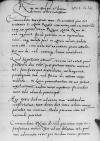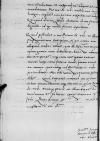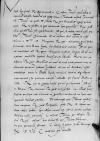Letter #2177
Samuel MACIEJOWSKI to Ioannes DANTISCUSCracow (Kraków), 1539-07-06
| received [1539]-07-15 Manuscript sources:
Prints:
| ||||||||
Text & apparatus & commentary Plain text Text & commentary Text & apparatus
Reverendissimo in Christo Patri et Domino, domino
Reverendissime in Christo Pater et Domine, domine observatissime.
Commendata servitute mea.
De
Quod dignitates attinet, verum est istud, quod proverbio dici solet, post festum venire miserum est. Iam fuerunt distributae me languente, priusquam litterae Vestrae Reverendissimae Dominationis essent mihi redditae. De lacu, quemadmodum se res habeat, nihil attinet eadem toties repetere, prioribus meis litteris abunde perscripsi. Ego hisce diebus adversa sum valetudine conflictatus, totos decem dies intra aedium mearum parietes me continui. Hodie primum data est exeundi potestas.
Commendatio Reverendissimae Dominationis Vestrae quantum mihi sit profutura, nescio. Hoc ad me delatum est, quod cum admonita esset per scribam suum, hominem  BCz, 1597, p. 710 mei studiosum, ut responderet aliquid ad commendationem Reverendissimae Dominationis Vestrae, vultu non satis benigno, negavit eam partem responsionis indigere hidden by binding⌈[re]re hidden by binding⌉. Quicquid Divina Maiestas statuere de me fuerit dignata, id ego animo feram aequissimo.
BCz, 1597, p. 710 mei studiosum, ut responderet aliquid ad commendationem Reverendissimae Dominationis Vestrae, vultu non satis benigno, negavit eam partem responsionis indigere hidden by binding⌈[re]re hidden by binding⌉. Quicquid Divina Maiestas statuere de me fuerit dignata, id ego animo feram aequissimo.
Quod postulat a me Reverendissima Dominatio Vestra, ut illius propugnationem suscipiam, si qui contra eam aliquid moliri velint, quo de
Quod superest, commendo me et servitutem meam iterum atque iterum in gratiam Reverendissimae Dominationis Vestrae Deumque precor, ut illam servet diu incolumem et felicem.
Dat(ae) or Dat(um)⌈Dat(ae)Dat(ae) or Dat(um)⌉
Eiusdem Dominationis Vestrae Reverendissimae servitor, Samuel hidden by binding⌈[uel]uel hidden by binding⌉ Macyeiovski decanu hidden by binding⌈[decanu]decanu hidden by binding⌉s et vicecancellarius
Nova haec sunt. Rediit
De intercepto per
Cetera si potero, scribam deinceps Reverendissimae Dominationi Vestrae. Cuius me gratiae commendo.



